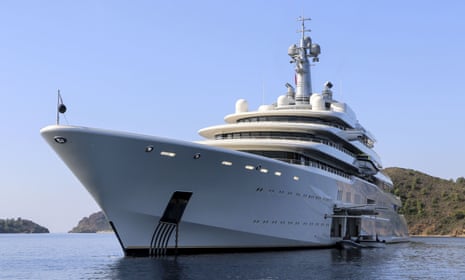No self-respecting oligarch these days can afford to be without a superyacht. Ownership of a bling boat is as obligatory as the Ferrari in the triple garage and the private jet on standby.
However, within months any billionaire wanting to sail their marine home into US waters will have to comply with stringent new environmental regulations to curb their hulking vessel’s polluting effects. The regulations, which stipulate that certain types of vessel built after 2016 have to be fitted with bulky equipment that converts nitrogen oxides into nitrogen and water, were presented to the International Maritime Organisation, the UN body responsible for reducing shipping pollution, but were resisted by trade bodies representing superyacht manufacturers. They protested that the proposed rules threatened their industry because the engine rooms of some superyachts were too small to accommodate the new equipment, meaning they would have to lose a guest cabin to make room for the technology.
A vociferous lobbying campaign was mounted, with some boat builders suggesting that the regulations represented a “doomsday” scenario for their industry. Russia, too, weighed in against the proposals. Amid the standoff, the US has opted to impose its own unilateral obligations, which come into force from 1 January in North America and the US Caribbean, and will force all newly built boats over 24m long and with a gross tonnage of 500 tonnes or more to cut their sulphur and nitrogen oxide emissions by nearly 80%. Experts predict that the regulations, which will apply to all vessels over 24m by 2021, would soon be rolled out to other maritime areas, including the Mediterranean.
Although the new US rules apply to all types of boat built from next year, it is their impact on superyachts that will be most noticeable. Environmental campaigners have expressed anger that, even when the cheapest of cars are equipped with anti-pollutant filters, superyachts have historically had to meet few environmental obligations to reduce their sizeable diesel emissions.
It reportedly costs more than £250,000 just to fill the fuel tanks of the Vava II, which is almost 100 metres long and was commissioned for a former Miss UK, Kirsty Bertarelli, by her billionaire husband Ernesto. The vessel is dwarfed by Russian billionaire Roman Abramovich’s 160m Eclipse, which can accommodate 36 guests in 18 cabins. U2 singer Bono owns the more modestly sized Kingdom Come which is 60m long and can hold up to 115,000 litres of fuel.
With the super-rich competing to build ever larger vessels, curbing diesel emissions is becoming a priority for engine builders who believe that incorporating anti-pollution systems into their next-generation designs represents a new marketing opportunity.
“These yachts can go up to 200 metres and everything is getting bigger and bigger and bigger,” said Ivo Van Den Berg, business manager at Zenoro, a company that specialises in fitting power systems to superyachts. “These boats need more than shore power can provide when they are moored up. You go to Monaco and you see lot of yachts running on generators all the time. When there is no wind, the emissions are like smog in the city.” Dan Houston, editor at classicsailor.com, said the shipping world was a major polluter that had been slow to clean up its act. “Around 95% of all that we use comes in by ships,” Houston said. “I live in Hove, and you can see the diesel fumes out at sea on certain days. The ships are trucking up and down through the straits of Dover, and when you can’t see the yellow smudge out to sea, that’s when you’re in it.”
Some studies suggest that the health risks of shipping pollution are worse than those caused by traffic pollution. It is claimed that one giant container ship can emit almost the same amount of cancer and asthma-causing chemicals as 50 million cars. A German report estimates that 60,000 deaths each year are caused by shipping pollution.
But, despite these concerns, the shipping world has not yet been subject to the same level of scrutiny as other polluting industries.

Comments (…)
Sign in or create your Guardian account to join the discussion